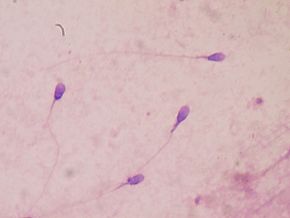 Take note: what is happening to dogs is also happening to men. Specifically, for many decades - year by year - there has been a decrease in male dog fertility. And yes, this is also happening with human male fertility - a decline in male semen quality (including sperm), along with an increase in the incidence of testicular cancer, the birth defect hypospadias, and undescended testes. This cluster of problems is called testicular dysgenesis syndrome (TGS), and it has an negative impact on male fertility.
Take note: what is happening to dogs is also happening to men. Specifically, for many decades - year by year - there has been a decrease in male dog fertility. And yes, this is also happening with human male fertility - a decline in male semen quality (including sperm), along with an increase in the incidence of testicular cancer, the birth defect hypospadias, and undescended testes. This cluster of problems is called testicular dysgenesis syndrome (TGS), and it has an negative impact on male fertility.
Dr Richard Lea, who led the research said: "This is the first time that such a decline in male fertility has been reported in the dog and we believe this is due to environmental contaminants..." and "While further research is needed to conclusively demonstrate a link, the dog may indeed be a sentinel for humans -- it shares the same environment, exhibits the same range of diseases, many with the same frequency, and responds in a similar way to therapies."
What chemicals were detected that affect male fertilty? Why, the same chemicals that appear again and again in studies and are linked to a number of health problems: endocrine disruptors. Yes, they are all around us - in our food, our homes, our everyday products, our environment. From Science Daily:
A study led by researchers at The University of Nottingham has discovered that the fertility of dogs may have suffered a sharp decline over the past three decades. The research, published in the academic journal Scientific Reports, found that sperm quality in a population of stud dogs studied over a 26-year period had fallen significantly.The work has highlighted a potential link to environmental contaminants, after they were able to demonstrate that chemicals found in the sperm and testes of adult dogs -- and in some commercially available pet foods -- had a detrimental effect on sperm function at the concentrations detected.
The study centered on samples taken from stud dogs at an assistance dogs breeding center over the course of 26 years. Professor Gary England.... said: "The strength of the study is that all samples were processed and analysed by the same laboratory using the same protocols during that time and consequently the data generated is robust." The work centred on five specific breeds of dogs -- Labrador retriever, golden retriever, curly coat retriever, border collie and German shepherd -- with between 42 and 97 dogs studied every year. Semen was collected from the dogs and analysed to assess the percentage of sperm that showed a normal forward progressive pattern of motility and that appeared normal under a microscope (morphology).
Over the 26 years of the study, they found a striking decrease in the percentage of normal motile sperm. Between 1988 and 1998, sperm motility declined by 2.5 per cent per year and following a short period when stud dogs of compromised fertility were retired from the study, sperm motility from 2002 to 2014 continued to decline at a rate of 1.2% per year. In addition, the team discovered that the male pups generated from the stud dogs with declining semen quality, had an increased incidence of cryptorchidism, a condition in which the testes of pups fail to correctly descend into the scrotum.
Sperm collected from the same breeding population of dogs, and testes recovered from dogs undergoing routine castration, were found to contain environmental contaminants at concentrations able to disrupt sperm motility and viability when tested. The same chemicals that disrupted sperm quality, were also discovered in a range of commercially available dog foods -- including brands specifically marketed for puppies. Dr Lea added: "We looked at other factors which may also play a part, for example, some genetic conditions do have an impact on fertility. However, we discounted that because 26 years is simply too rapid a decline to be associated with a genetic problem."
Over the past 70 years, studies have suggested a significant decline in human semen quality and a cluster of issues called 'testicular dysgenesis syndrome' that impact on male fertility which also include increased incidence of testicular cancer, the birth defect hypospadias and undescended testes.
However, declining human semen quality remains a controversial issue -- many have criticised the variability of the data of the studies on the basis of changes in laboratory methods, training of laboratory personnel and improved quality control over the years. Dr Lea added: "The Nottingham study presents a unique set of reliable data from a controlled population which is free from these factors. This raises the tantalising prospect that the decline in canine semen quality has an environmental cause and begs the question whether a similar effect could also be observed in human male fertility."
Excerpts from the original study in Scientific Reports: Environmental chemicals impact dog semen quality in vitro and may be associated with a temporal decline in sperm motility and increased cryptorchidism
A significant decline in human semen quality over the last 70 years has been widely reported1,2. The first meta-analysis reporting this phenomenon included 61 studies selected over a 50 year period (1938–1991)1 and such a trend was confirmed by re-analysis with an additional 47 studies included2.....Nevertheless, reports of declining sperm counts linked with epidemiological data on increased incidences of testicular cancer and genital tract abnormalities, is indicative of an adverse environmental effect on male reproduction6,7,8. Since these reproductive problems, termed by some as “testicular dysgenesis syndrome” (TDS), cluster in geographical areas9 they are thought to have a common aetiology and have been associated with endocrine perturbations in early life10. Exposure of developing males to environmental chemicals, particularly those with endocrine disrupting activity, is thought to be the initiator11. Although periods of development particularly sensitive to exposure encompass both pre-natal and pre-pubertal periods, environmental chemicals also perturb adult testis function e.g. gene expression and meiosis12.
As ‘man’s best friend’ and closest animal companion, the dog shares the same environment, exhibits the same range of diseases, many with the same frequency, and responds in a similar way to therapeutic treatments. There is evidence that over the last 40 years, the incidence rate of canine testicular cancer has increased in parallel with changes seen in humans17,18. In addition, histological signs which characterise human TDS have recently been described in the dog19. These include seminiferous tubule abnormalities and testicular germ cell neoplasia in situ (GCNIS) cells which are known precursors of seminomas in the human20. Since human TDS includes a reduction in sperm count21 and an increased incidence of cryptorchidism, we hypothesised that the dog may exhibit similar manifestations of TDS and that this may be associated with exposure to endocrine disrupting chemicals.
The dog is probably man’s closest companion and by sharing the same habitat, is likely to be exposed to similar environmental conditions including environmental chemicals. This was especially true in the current study since the dogs lived in homes with their handlers. Twelve chemicals detected in adult dog testes (DEHP, 7 PCB congeners, 4 PBDE congeners) were also detected in the 15 commercially available dog foods analysed.

 The research finding that eating fruits and vegetables with high pesticide residues has a negative effect on sperm is disturbing. It wasn't the amount of fruits and vegetables eaten, it was eating fruits and vegetables with high levels of pesticide residues. Yes, the study does have some limitations (for example, a one time analysis, looked at men at a fertility clinic and not the general population), but...even with these limitations, the results are disturbing.
The research finding that eating fruits and vegetables with high pesticide residues has a negative effect on sperm is disturbing. It wasn't the amount of fruits and vegetables eaten, it was eating fruits and vegetables with high levels of pesticide residues. Yes, the study does have some limitations (for example, a one time analysis, looked at men at a fertility clinic and not the general population), but...even with these limitations, the results are disturbing.